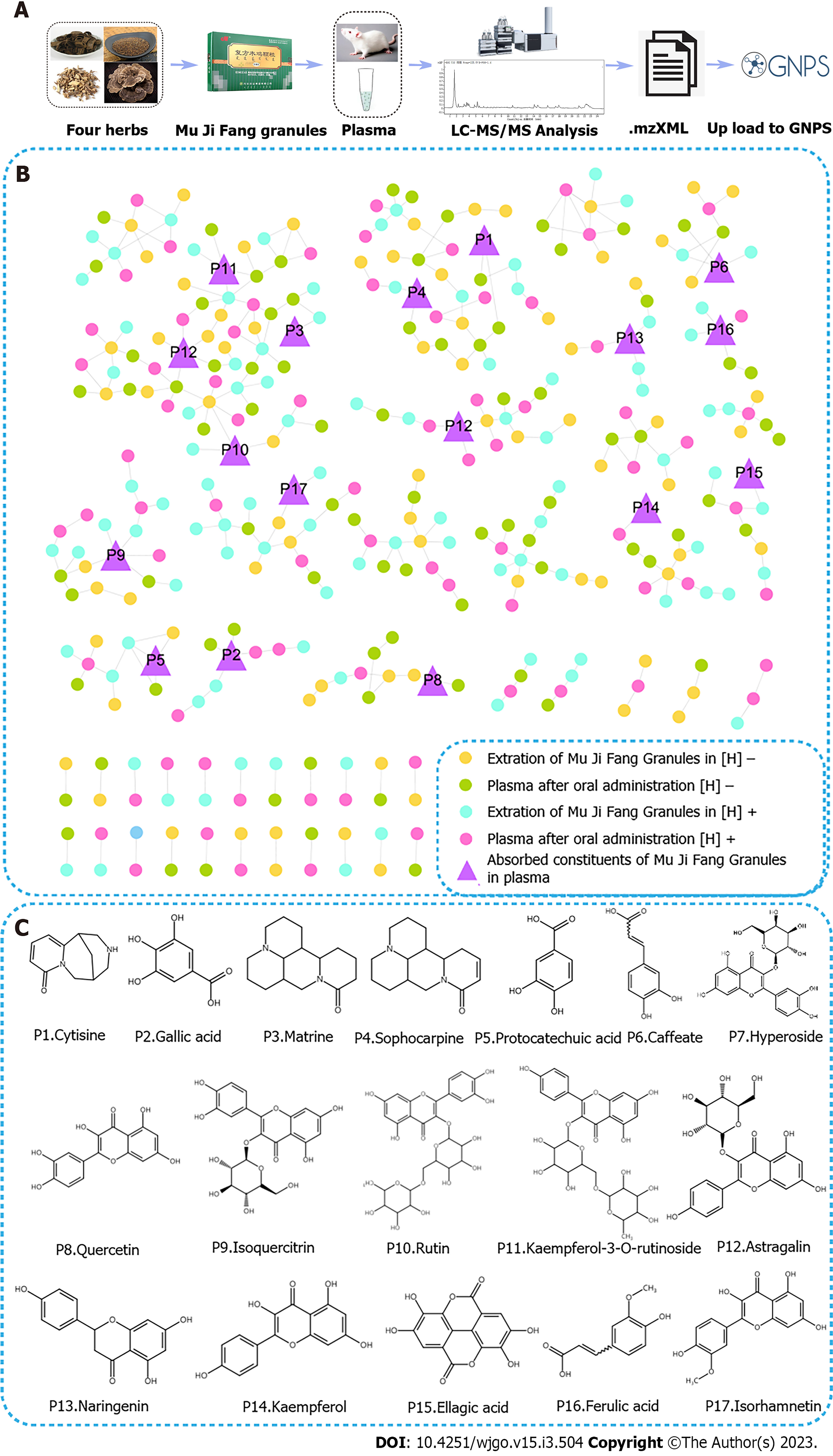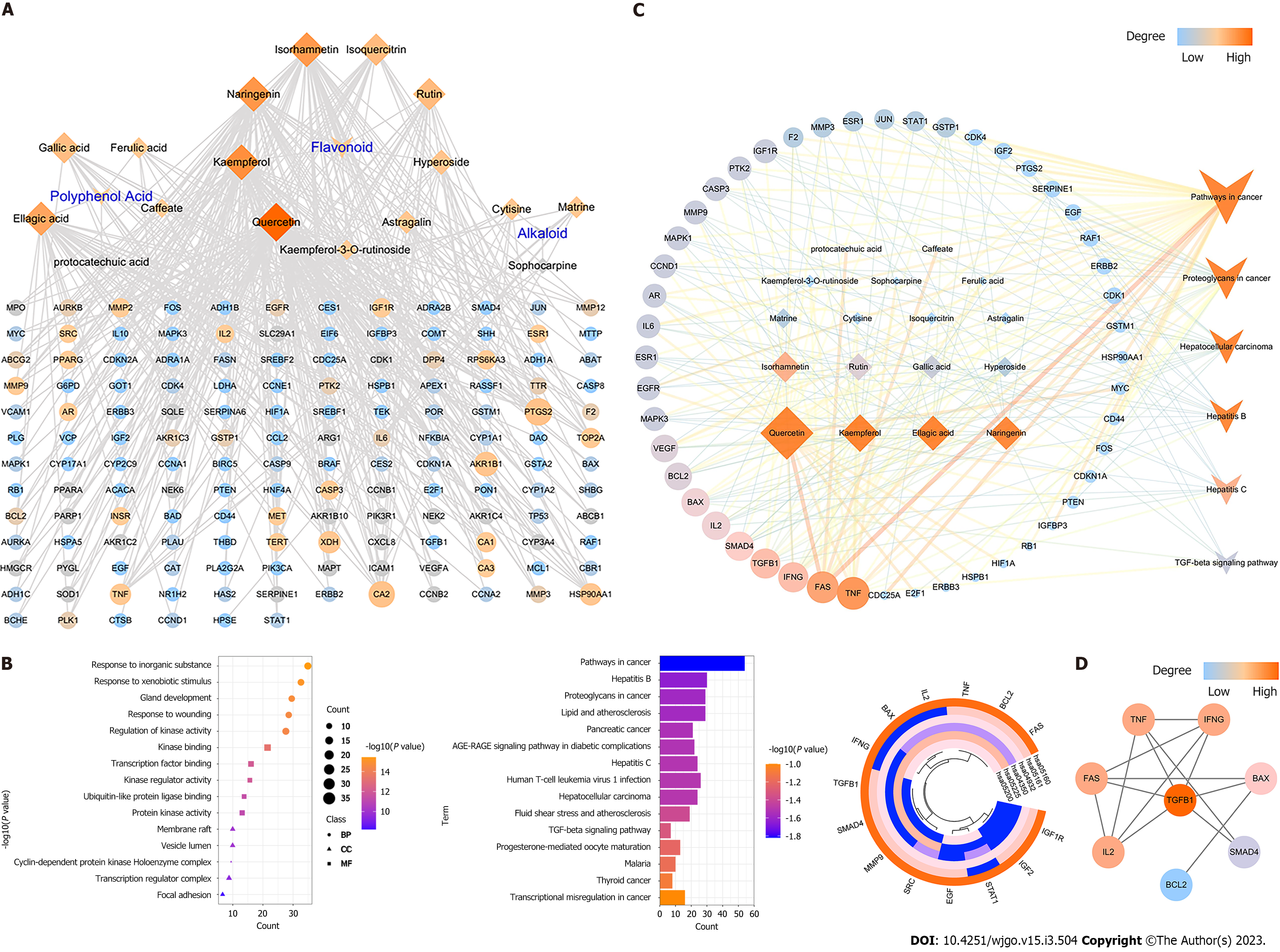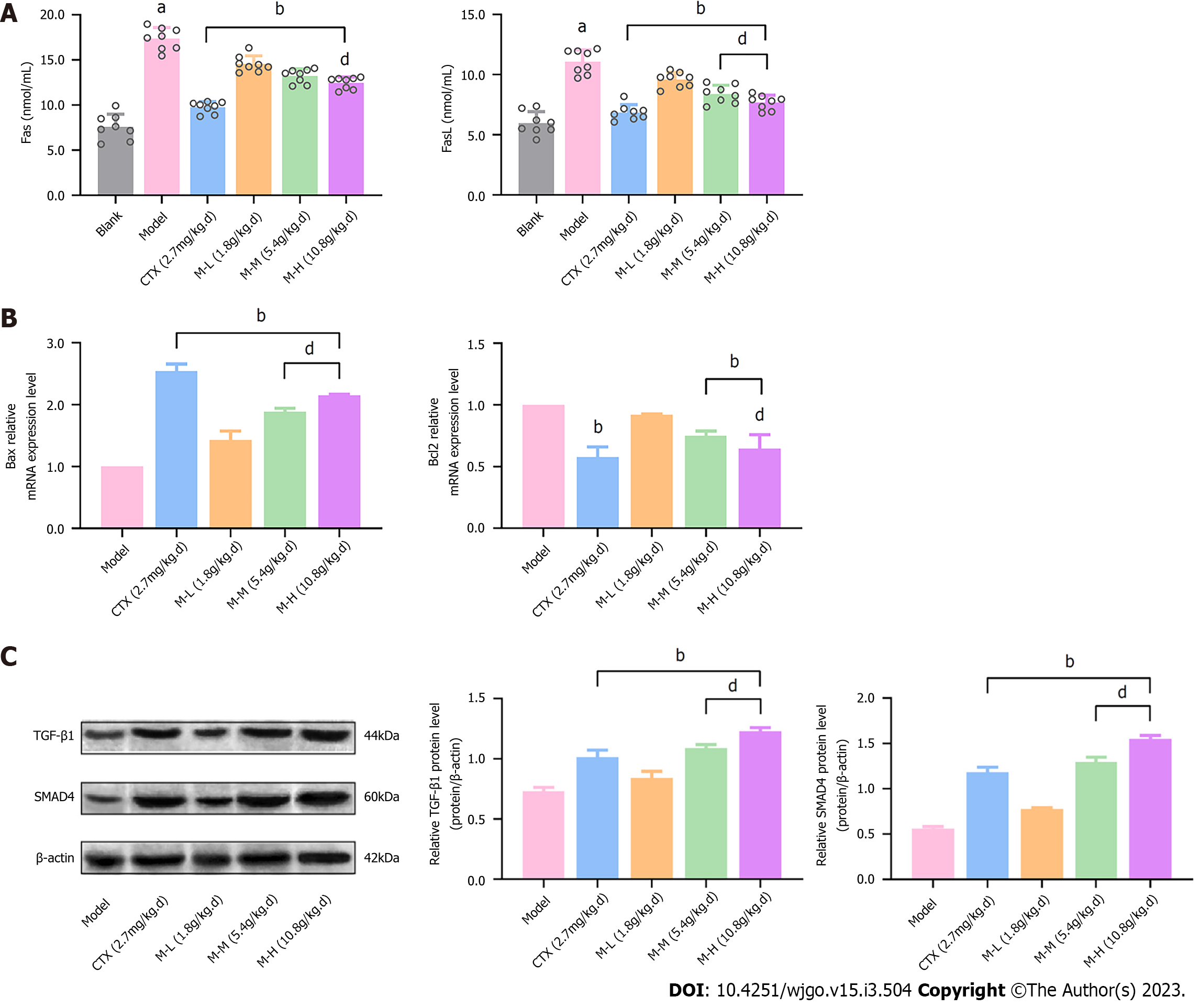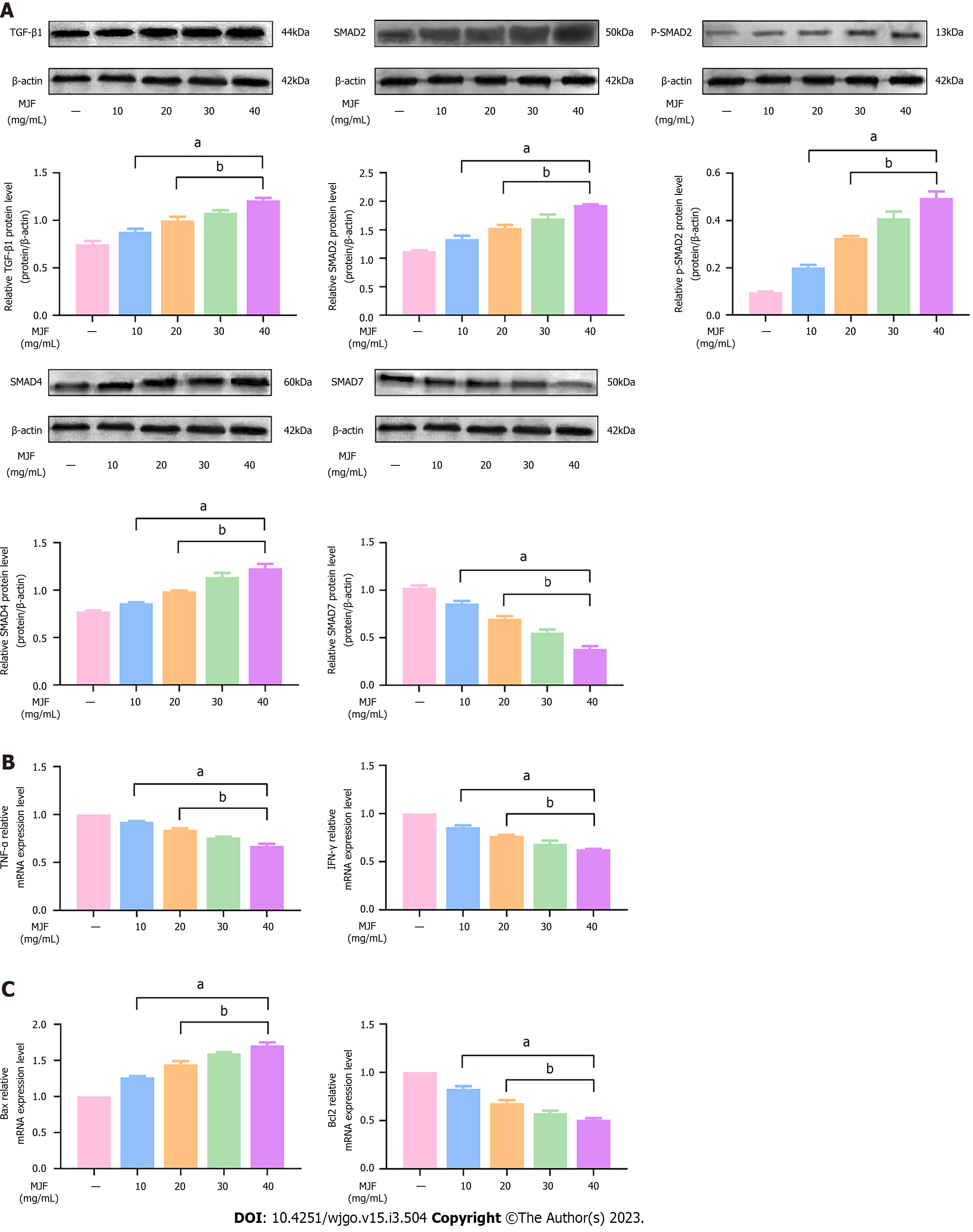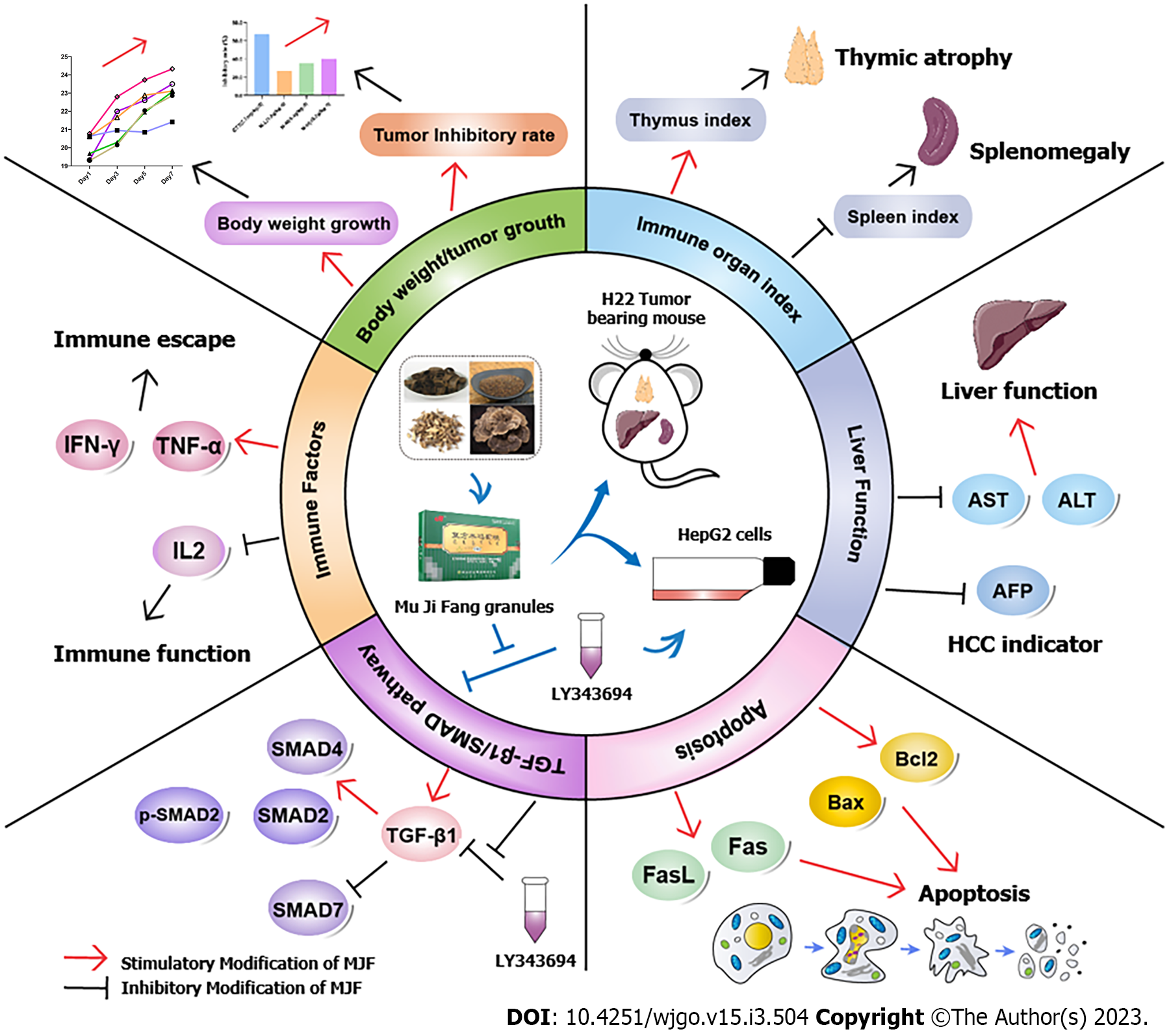Copyright
©The Author(s) 2023.
World J Gastrointest Oncol. Mar 15, 2023; 15(3): 504-522
Published online Mar 15, 2023. doi: 10.4251/wjgo.v15.i3.504
Published online Mar 15, 2023. doi: 10.4251/wjgo.v15.i3.504
Figure 1 Establishment of H22 tumor-bearing mice.
CTX: Cyclophosphamide; MJF: Mu Ji Fang Granules.
Figure 2 Identification of the absorbable ingredients in Mu Ji Fang Granules using molecular networking.
A: Workflow of the molecular networking approach; B: Whole molecule networking profile of Mu Ji Fang Granules after oral administration; C: Absorbable ingredients identified using reference substances. mzXML: A kind of format for Mass spectrometry data file. GNPS: Website of Global Nature Products Social Molecular Networking; LC-MS/MS: Liquid Chromatograph Mass Spectrometer.
Figure 3 Network pharmacology construction and pathway enrichment analysis of Mu Ji Fang Granules.
A: Ingredients-anti-hepatocellular carcinoma (HCC)-targets network of Mu Ji Fang Granules (MJF) (diamond represents ingredients and ellipse represents targets). The color of the nodes from blue to red indicate the degree from low the high; B: Gene Ontology (GO) and Kyoto Encyclopedia of Genes and Genomes (KEGG) pathway enrichment analysis and heatmap of the 14 most significantly different abundant genes related to the 6 KEGG pathways of HCC (BP: Represents Biological Process; CC: Represents Cellular Component; and MP: Represents Molecular Function); C: Ingredient-anti-HCC-pathway-target network of MJF (diamond represents ingredients, octagon represents targets and V represents pathway). The color of the nodes from red to yellow to green to blue indicates the degree from high to low; D: Hub targets of MJF most closely related to HCC. TNF: Tumor necrosis factor; TGF: Transforming growth factor; SMAD4: Mothers against decapentaplegic homolog 4; IL: Interleukin; FAS: TNF superfamily receptor 6.
Figure 4 Mu Ji Fang Granules improved average body weight, spleen and thymus indices, decreased the concentration of hepatocellular carcinoma indicators, liver function indicators and immune factors.
A: Average body weight, spleen index and thymus index (n = 8); B: Concentrations of hepatocellular carcinoma indicator alpha-fetoprotein, liver function indicators alanine aminotransferase and aspartate aminotransferase and immune factors Tumor necrosis factor α, Interferon gamma and Interleukin-2 in serum (n = 8); C: Tumor tissue from H22 tumor-bearing mice and the tumor inhibitory rate (n = 8); D: Hematoxylin and eosin staining of tumor tissue pathology sections from H22 tumor-bearing mice (n = 3). Data are shown as the mean ± standard deviation. aP < 0.01 vs Blank. bP < 0.01 vs Model. cP < 0.05 vs Model. dP < 0.01 vs M-L. eP < 0.05 vs M-L.
Figure 5 Mu Ji Fang Granules improved apoptosis and regulated the Transforming growth factor β1/ Mothers against decapentaplegic homolog signaling pathway in H22 tumor-bearing mice.
A: The concentration of Fas and FasL in serum (n = 8); B: Relative expression of Bax and Bcl2 mRNA in tumor tissue (n = 3); C: Relative expression of Transforming growth factor β1 and Mothers against decapentaplegic homolog 4 protein in tumor tissue (n = 3). Data are shown as the mean ± standard deviation. aP < 0.01 vs Blank. bP < 0.01 vs Model. dP < 0.01 vs M-L.
Figure 6 Mu Ji Fang Granules modulated the Transforming growth factor β1/ Mothers against decapentaplegic homolog signaling pathway and improved the expression of immune and apoptotic cytokines in HepG2 cells.
A: Relative expression of Transforming growth factor β1, Mothers against decapentaplegic homolog (SMAD) 2, p-SMAD2, SMAD4, and SMAD7 protein; B: Relative expression of Tumor necrosis factor α and Interferon gamma mRNA; C: Relative expression of Bax, and Bcl2 mRNA (n = 4). Data are shown as the mean ± standard deviation. aP < 0.01 vs Control [Mu Ji Fang Granules (MJF) 0 mg/mL]. bP < 0.01 vs MJF 10 mg/mL.
Figure 7 Mu Ji Fang Granules alleviated the modulation of Transforming growth factor β1 inhibitor (LY364947) on the Transforming growth factor β1/ Mothers against decapentaplegic homolog signaling pathway, immune and apoptotic cytokines in HepG2 cells.
A: Relative expression of Transforming growth factor β1(TGF-β1), Mothers against decapentaplegic homolog (SMAD) 2, p-SMAD2, SMAD4, and SMAD7 protein following treatment of HepG2 cells with TGF-β1 inhibitor (LY364947); B: Relative expression of Tumor necrosis factor α and Interferon gamma mRNA following treatment of HepG2 cells with TGF-β1 inhibitor (LY364947); C: Relative expression of Bax, and Bcl2 mRNA following treatment of HepG2 cells with TGF-β1 inhibitor (LY364947) (n = 4). Data are shown as mean ± standard deviation. aP < 0.01 vs Control [Mu Ji Fang Granules (MJF) 0 mg/mL]. bP < 0.05 vs Control [Mu Ji Fang Granules (MJF) 0 mg/mL]. cP < 0.01 vs Mu Ji Fang Granules 10 mg/mL. dP < 0.05 vs Mu Ji Fang Granules 10 mg/mL.
Figure 8 Overview of the possible anti-hepatocellular carcinoma effects of Mu Ji Fang Granules.
CTX: Cyclophosphamide; IFN-γ: Interferon gamma; TNF-α: Tumor necrosis factor α; IL: Interleukin; SMAD: Mothers against decapentaplegic homolog; TGF: Transforming grow; MJF: Mu Ji Fang Granules; AST: Aspartate aminotransferase; ALT: Alanine aminotransferase; AFP: Alpha-fetoprotein; HCC: Hepatocellular carcinoma.
- Citation: Zhang YB, Bao YR, Wang S, Li TJ, Tai H, Leng JP, Yang XX, Wang BC, Meng XS. Possible mechanisms associated with immune escape and apoptosis on anti-hepatocellular carcinoma effect of Mu Ji Fang granules. World J Gastrointest Oncol 2023; 15(3): 504-522
- URL: https://www.wjgnet.com/1948-5204/full/v15/i3/504.htm
- DOI: https://dx.doi.org/10.4251/wjgo.v15.i3.504










